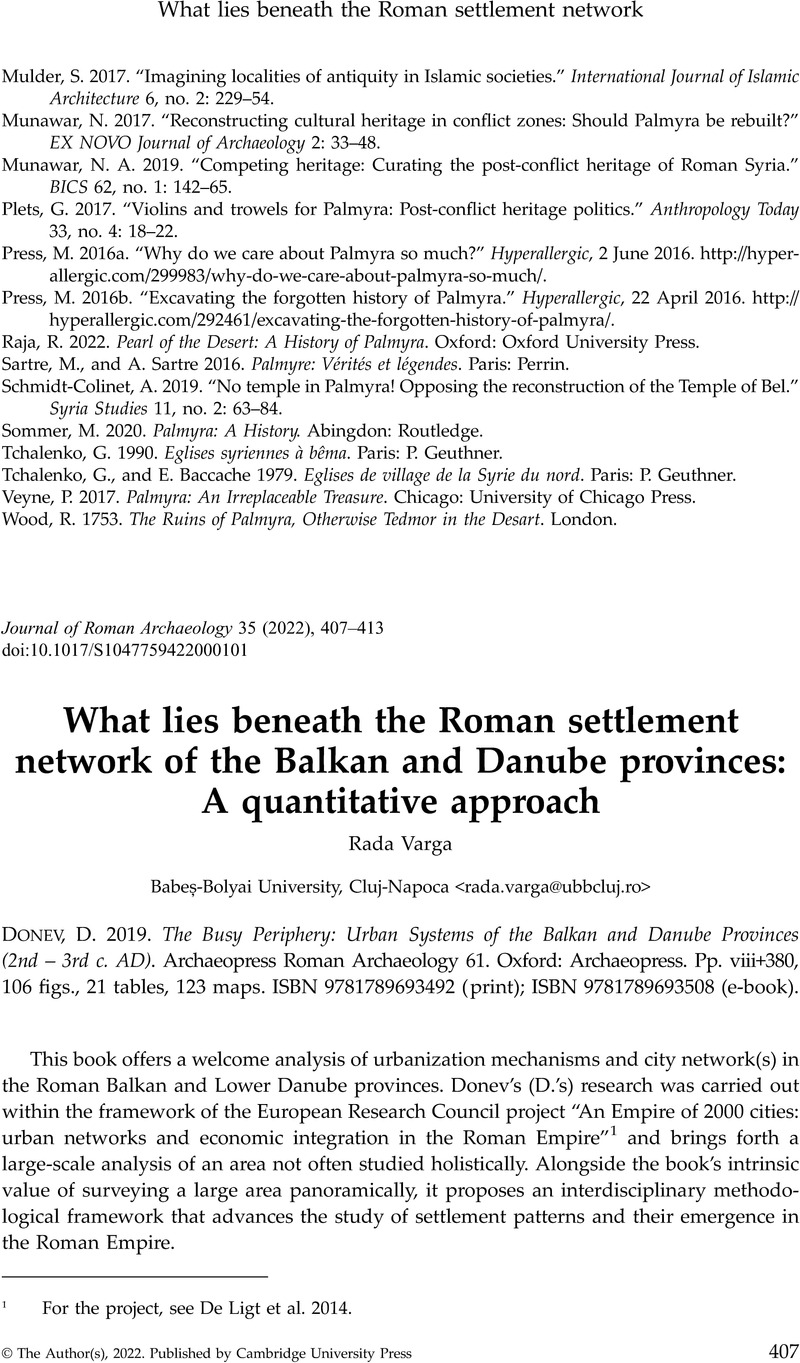No CrossRef data available.
Article contents
What lies beneath the Roman settlement network of the Balkan and Danube provinces: A quantitative approach - D. Donev 2019. The Busy Periphery: Urban Systems of the Balkan and Danube Provinces (2nd – 3rd c. AD). Archaeopress Roman Archaeology 61. Oxford: Archaeopress. Pp. viii+380, 106 figs., 21 tables, 123 maps. ISBN 9781789693492 (print); ISBN 9781789693508 (e-book).
Review products
D. Donev 2019. The Busy Periphery: Urban Systems of the Balkan and Danube Provinces (2nd – 3rd c. AD). Archaeopress Roman Archaeology 61. Oxford: Archaeopress. Pp. viii+380, 106 figs., 21 tables, 123 maps. ISBN 9781789693492 (print); ISBN 9781789693508 (e-book).
Published online by Cambridge University Press: 29 April 2022
Abstract
An abstract is not available for this content so a preview has been provided. Please use the Get access link above for information on how to access this content.

- Type
- Book Review
- Information
- Copyright
- Copyright © The Author(s), 2022. Published by Cambridge University Press
References
Bintliff, J. 1999. “Settlement and territory.” In Companion Encyclopedia of Archaeology, ed. Barker, G., 505–45. London: Routledge.Google Scholar
Hagget, P. 1965. Location Analysis in Human Geography. London: Edward Arnold Publishing House.Google Scholar
Hanson, J. W. 2016. An Urban Geography of the Roman World (100 BC to AD 300). Archaeopress Roman Archaeology 18. Oxford: Archaeopress.CrossRefGoogle Scholar
Hanson, W. S., and Haynes, I. P., eds. 2004. Roman Dacia. The Making of a Provincial Society. JRA Supplement Series 56. Portsmouth: Journal of Roman Archaeology.Google Scholar
Houten, P. 2021. Urbanisation in Roman Spain and Portugal: Civitates Hispaniae in the Early Empire. London and New York: Routledge.CrossRefGoogle Scholar
Isaac, B. 2017. “Core-periphery notions.” In Empire and Ideology in the Graeco- Roman World: Selected Papers, ed. Isaac, B., 99–121. Cambridge: Cambridge University Press.CrossRefGoogle Scholar
Ivaylo, L. 2015. “Roman Thrace.” In A Companion to Ancient Thrace, ed. Valeva, J., Nankov, E., and Graninger, D., 75–90. Blackwell Companions to the Ancient World. Chichester: Wiley Blackwell.Google Scholar
Lengyel, A., and Radan, G. T., eds. 1980. The Archaeology of Roman Pannonia. Budapest: Akadémiai Kiadó.Google Scholar
Ligt, L. de, Houten, P., and Willet, R.. 2014. “An empire of 2000 cities: urban networks and economic integration in the Roman Empire.” Tijdschrift voor Mediterrane Archeologie 52: 64.Google Scholar
Mitthof, F. 2014. “Sarmizegetusa? Zu den Varianten eines dakischen Toponyms in den lateinischen und griechischen Quellen.” In Trajan und seine Städte. Colloquium Cluj-Napoca, 29. September–2. Oktober 2013, ed. Piso, I. and Varga, R., 233–244. Cluj-Napoca: Mega Publishing House.Google Scholar
Raja, R., and Sindbæk, S. M., eds. 2018. Urban Network Evolutions: Towards a High-Definition Archaeology. Aarhus: Aarhus University Press.Google Scholar
Sanader, M. 2009. Dalmatia. Eine römische Provinz an der Adria. Mainz: Philipp von Zabern.Google Scholar
Šašel Kos, M., and Scherrer, P., eds. 2002. The Autonomous Towns of Noricum and Pannonia / Die autonomen Städte in Noricum und Pannonien. Ljubljana: Narodni muzej Slovenije.Google Scholar


